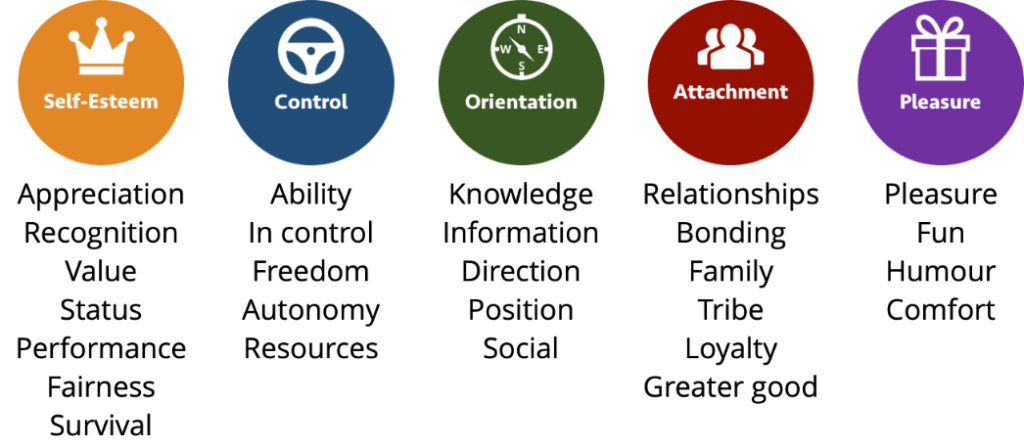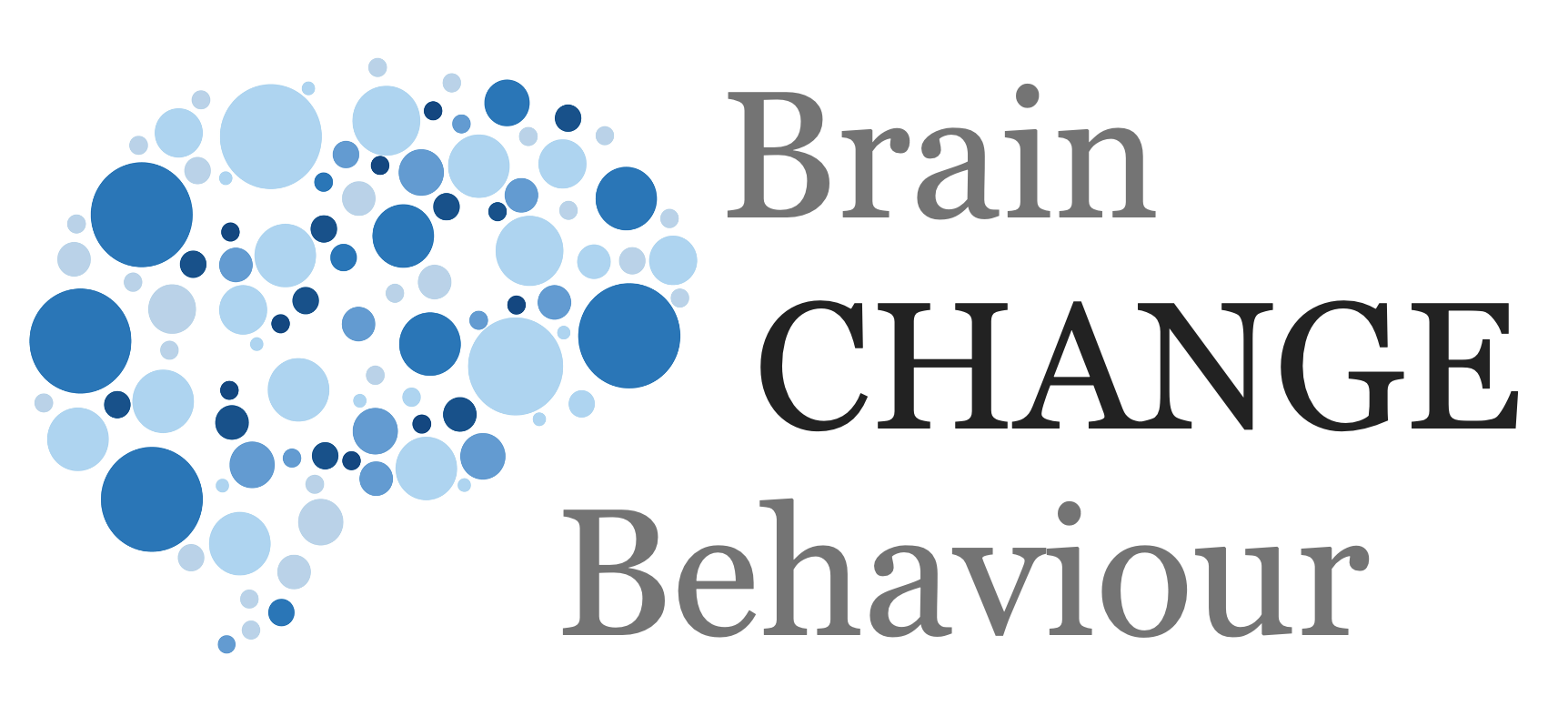Article
SCOAP Framework
See also: SCOAP Introduction SCOAP Needs SCOAP Motivation SCOAP Behaviour SCOAP Change

As we have outlined in the introduction, SCOAP is an acronym for:
-
- Self-Esteem
- Control
- Orientation
- Attachment
- Pleasure
These are basic human needs which means fulfilling them is essential for human wellbeing and therefore also that having them unfulfilled or violated lowers human wellbeing. These also direct human motivation and subsequently human behaviours. Each need consists of multiple sub-dimensions:

The various dimensions of the SCOAP needs.
Self-Esteem
Self-esteem is a need that revolves around the self, the individual. The most obvious factors that are included in the need for self-esteem are to do with appreciation, recognition, and value. This can be with your friends where you feel valued, with your family, and within your job where you are appreciated for your contribution. We all know, and multiple lines of research have shown, how important and critical this is to motivation and engagement. It is so critical because it is a basic human need. This concept of self-esteem is present at all levels in larger groups – there will also be status factors such as job titles, but also the various status symbols that we have.
-
- Appreciation and recognition: feeling appreciated and / or recognised
- Value: feeling valued, as a person, or for your contribution
- Status: having status, often formally through things like job titles, but also informally
- Performance: being a good performer or noted for high performance
- Fairness: being treated fairly in comparison to others, particularly peers
- Survival: being able to survive, protect oneself, or feel safe
- Self-identity: how you identify with yourself
When we think of change we will need to think of how change will impact self-esteem. Does it have an ability to increase self-esteem? If so, this will make change easier. Will it negatively impact self-esteem? If so, it will make change difficult.
However, in change initiatives this can be communicated with messaging carefully crafted to engage activation of the needs. This is often neglected or forgotten at a society level or in business change initiatives. This is often because they are initiated from leadership or senior senior leadership and the change will benefit their self-esteem but may damage the self-esteem of those lower in the organisation.
Control
Control is a need that includes two contrasting but related concepts. The first is the obvious of having, or being in, control. This can include simply having the ability to do something, to having the authority or the ability to influence contexts. But on the other hand is also about having freedom or autonomy – both of these have been researched extensively in business contexts and are known to have positive effects on motivation, productivity, and engagement. Freedom however, is related to control because it gives choice and ability to control what one wants when one wants. Control includes
-
- Ability: having the ability, competencies, and skills to do something
- Resources: often resources can be a limiting factor so having the resources be that time, finances, or supplies is important
- Freedom and autonomy: having the freedom and autonomy to make personal choices and decisions
- Influence: being able to influence a situation. This could be through, for example, communication ability, or alternatively authority and status
- Self-Control: being able to control oneself, one’s thought processes, focus, and avoid distractions and impulses
- Power: having the authority or strength to be able to make decisions and control situations
- In-Control: the general ability to be in control and “have things under control”
It is easy to disrupt the need of control in change situations because change can be imposed on you. This, often, but not necessarily, violates the need for control. This is why self-initiated actions, or self-initiated desire for change is much better for driving change processes. Similarly giving some choice in change processes positively targets the need of control giving some control over the situation.
Orientation
Orientation is a need which revolves around information and knowing things. We naturally desire to know things be that in navigational contexts, going from one place to another, to having social information (who is who and responsible for what), to having information and knowledge. We probably all know how frustrating and disruptive missing information can be – being in a blackhole of knowledge. Orientation includes:
-
- Knowledge: this is having the specific knowledge to carry out various tasks or specific to your role
- Information: having general information to know what is happening
- Direction: understanding the future direction of yourself, the company, or your project
- Position: knowing your position
- Social: having knowledge of others
Orientation is commonly disrupted in change processes but many change processes and consultants do realise the importance of communication and clarity of communication. However, it is still very easy to underestimate and get wrong – particularly if people are nervous and anxious, any lack of information will make this worse. It is also easy to forget to inform people or alternatively give inconsistent information.
Attachment
Attachment is a need that most consider one of the most important if not the most important need (we do warn against prioritising, however). Attachment refers to everything to do with relationships and how people relate to and bond with each other. This includes the different forms of this which range from romantic love, to family love, friendships, trust, loyalty, and doing things for others you don’t know, being charitable. Attachment includes:
-
- Relationships: this broadly refers to how good your relationships are with others
- Bonding: this refers to the closeness you feel in your relationships
- Family: refers to the love and closeness you have with direct members of your family
- Tribe: refers to forming groups with a purpose be that in clubs or organisations
- Loyalty: is related to the above but refers to how loyal you feel and how you experience loyalty from others
- Greater good: refers to how you relate to doing good for society which includes being charitable and helping strangers
Attachment is a need that is rarely focused on in change initiatives and can also be at threat. Change can disrupt relationships but also in certain circumstances also disrupt loyalty. We need to think of how change can disrupt attachment but also how to target communication at this need also.
Pleasure
Pleasure is an obvious need. Having pleasurable experiences is, obviously, good. Having negative, unpleasurable experiences is, obviously, bad. What you may notice, however, is that all of the above four needs also lead to positive feelings of pleasure. It feels good to be appreciated, it feels good to be in control, it feels good to know what is happening, it feels good to have good relationships. Therefore we should distinguish, where possible, pleasure for the sake of pleasure from the above where possible (which may be difficult).
-
- Comfort: refers to being firstly without discomfort, or pain, and then being comfortable, whether physically or psychologically
- Pleasure: refers to having pleasurable experiences those that stimulate more positivity than comfort alone
- Fun: is about having fun which includes pleasure and stimulus
- Humour: is the particularly human trait of being able to laugh about things and also see the funny side
Change has the ability to disrupt pleasure. Change can be effortful, and mean moving out of comfort into discomfort. It may also not be fun – therefore change can meet resistance. By focusing on more positive aspects of change we can make change easier – businesses rarely focuses on this aspect.
See also: SCOAP Introduction SCOAP Needs SCOAP Motivation SCOAP Behaviour SCOAP Change
Simple Takeaways
- Target SCOAP needs to formulate change messaging i.e. how it will increase the needs
- Analyse using SCOAP to predict where there will be resistance e.g. if change can damage a need
- For individual change target an individual’s needs, for population change target SCOAP needs in general
© leading brains 2022
References
Habermacher, A., Ghadiri, A., and Peters, T. (2020). Describing the elephant: a foundational model of human needs, motivation, behaviour, and wellbeing. doi:10.31234/osf.io/dkbqa.
Habermacher, A., Ghadiri, A., and Peters, T. (2014). The case for basic human needs in coaching: A neuroscientific perspective – The SCOAP Coach Theory. Coach. Psychol. 10, 7–16.
Ghadiri, A., Habermacher, A., and Peters, T. (2012). Neuroleadership – A Journey Through The Brain for Business Leaders. Berlin: Springer.
Habermacher, A. (2016). Evolutionary Levels of Behaviour: A Framework for Leadership. in 6th International Coaching Psychology Conference. (London, United Kingdom), Oral Presentation.
Ghadiri, A. (2017). Bedürfnisse messen – Eine empirische Studie im organisationalen Kontext. Zeitschrift für Führung und Organ. 1, 18–23.
More Articles
The supply side of scaling
There are a number of problems with the supply side – being able to supply the resources and competencies to drive change.
Unintended consequences and negative spillovers
We all know that any change – well, obviously, changes something. But this also means there will be various knock-on effects
Representativeness of the Situation
“You had to be there” is an expression that says you had to be in a particular situation, in that particular vibe, to fully understand a situation.
Representativeness of the Population
When we get a good idea, we may know it is a good thing. And because we know it is a good thing we may then falsely assume – without really thinking this through – that everybody thinks this is a good thing.
False Positives – The inference problem
A false positive has become better-known to the general public during the pandemic and with COVID-19 testing particularly with home based quick tests.





